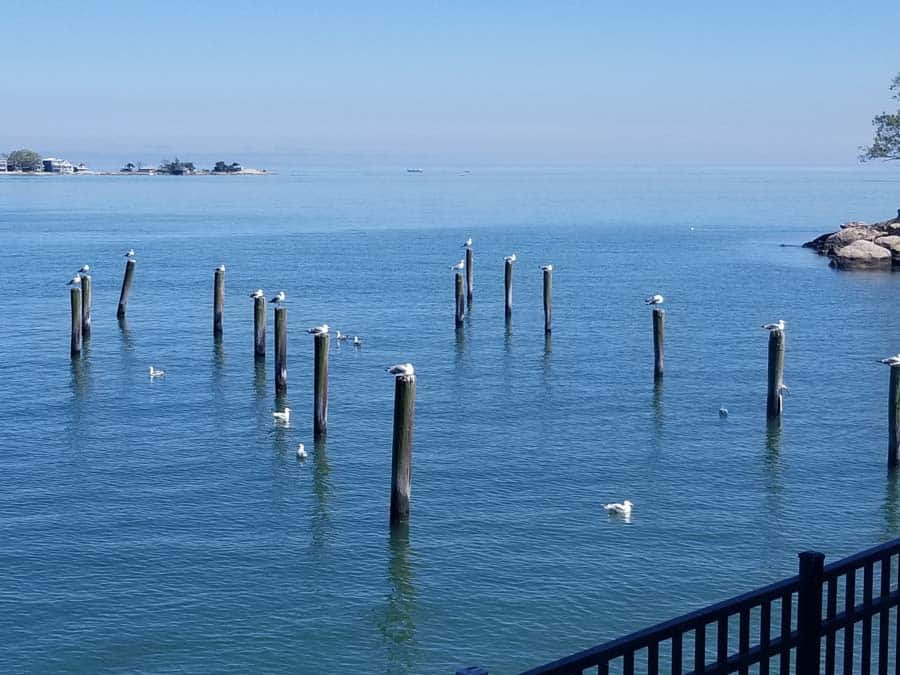Please view our updated COVID-19 guidelines and visiting procedures →.

One special aspect of our gorgeous waterfront setting is the chance to be part of the circle of life. All year long we see nature in its many forms, from storms and wind in winter, to sun and flowers in bloom in summer. One season stands out, though, and that is spring—which is full of life in every way, especially with birds returning to visit, and to nest. Even among the bird population, one species stands out: Gulls are everywhere.

We pay a lot of attention to gulls. The variety we have at Connecticut Hospice are commonly called seagulls by most people, although technically they are usually herring gulls—named for one of the types of fish that they like to eat. They arrive in force at the end of winter, and they appear on every angle of our building, as well as along the water and on the grass. If you look at our building from afar, you can see them perched like little soldiers, guarding their territory. And they do consider it theirs!

Gulls mate for life, and they return to build nests on flat surfaces. That includes our roof and our balconies. Nesting birds are protected, so even our much-needed roof repair had to be done so as to avoid mating season. Once they build their nests, mostly out of grass and twigs, we can’t go anywhere near them. They are fiercely protective of their eggs, and the male and the female gulls take turns sitting on the nest. They will screech, fly at, or peck on the windows of people they find too intrusive.
Gulls lay around 3 eggs a year, and those that hatch spend about six weeks being fed with regurgitated food that both the male and the female bring back to the nest. At the end of that time, they are ready to fly.


When they aren’t being doting parents, they are often viewed as pests by those of us inured to their charms. They scavenge, to the point that they can swoop in and take a sandwich right out of someone’s hand. They also eat a lot of garbage, as well as fish, mice, and earthworms. Apparently, some groups of gulls can coordinate a stomping brigade, that can fool earthworms into coming aboveground, thinking that it’s raining.


Once they have reproduced, they seem less ubiquitous, although they remain a presence everywhere around our grounds. They share our back lawn with geese, and we all know about goose droppings, and how much we enjoy having those around. One of the neighbors who came to one of our vaccination clinics earlier in the year offered to bring her poodle by every day, to help chase the geese off the lawn. Good luck with that!
It seems everywhere on the Shoreline that large predatory birds have increased in number over the past few years. It’s common to see osprey (often carrying fish in their talons), hawks (ditto), and bald eagles can occasionally be spotted as well. Herons are abundant, although rarer for us to see from the building. Patients and their families not only go outside to view all the wildlife, but they bring binoculars to enjoy the viewing. We also have a very good telescope in the common room.

Watching the birds is a wonderful reminder of both joy and sorrow. Their lives can be harsh, and short, but they look so beautiful and free as they soar gracefully above the sparkling water. Gulls are even able to remain motionless in the air, by angling their bodies in a particular way to catch the wind correctly.
They remind us too, in their laser focus on finding and bringing back the next meal, that moments matter, and should be cherished and shared with loved ones, whether in a nest or by a bed.
We are including a few amazing photographs, taken by a new volunteer, for you to enjoy. We hope that you will find beauty in them, and in all of nature’s bounty. And may your spirits soar as these birds do.


As a not-for-profit, we depend on generous donors to help us provide customized services and therapies that aren’t completely covered by Medicaid, Medicare, or private insurance.
Please make a gift to help us sustain the highest standard of care.
Admissions may be scheduled seven days a week.
Call our Centralized Intake Department: (203) 315-7540.